A Detailed Analysis of Knowledge Sharing in Public Sector Orgs
VerifiedAdded on 2023/06/04
|21
|3341
|221
Report
AI Summary
This report presents an analysis of two journal articles focusing on knowledge sharing within public sector organizations. The first article, "Determinants of Knowledge Sharing in a Public Sector Organization," investigates factors influencing knowledge sharing, utilizing quantitative research methods and questionnaires to identify key considerations like community, personal beliefs, social interaction, and organizational support. It concludes that organizational support, rewards, and social interaction are vital for effective knowledge sharing. The second article, "Fostering Knowledge Sharing Behavior Among Public Sector Managers: A Proposed Model for the Malaysian Public Service," explores knowledge sharing behavior among Malaysian public service employees, proposing a conceptual model based on literature review. It identifies self-efficacy, enjoyment in helping others, reciprocity, trust, and social networks as key predictors of knowledge sharing behavior. Both articles contribute to understanding the dynamics of knowledge sharing, offering implications for organizational managers to implement effective strategies and foster a supportive environment.
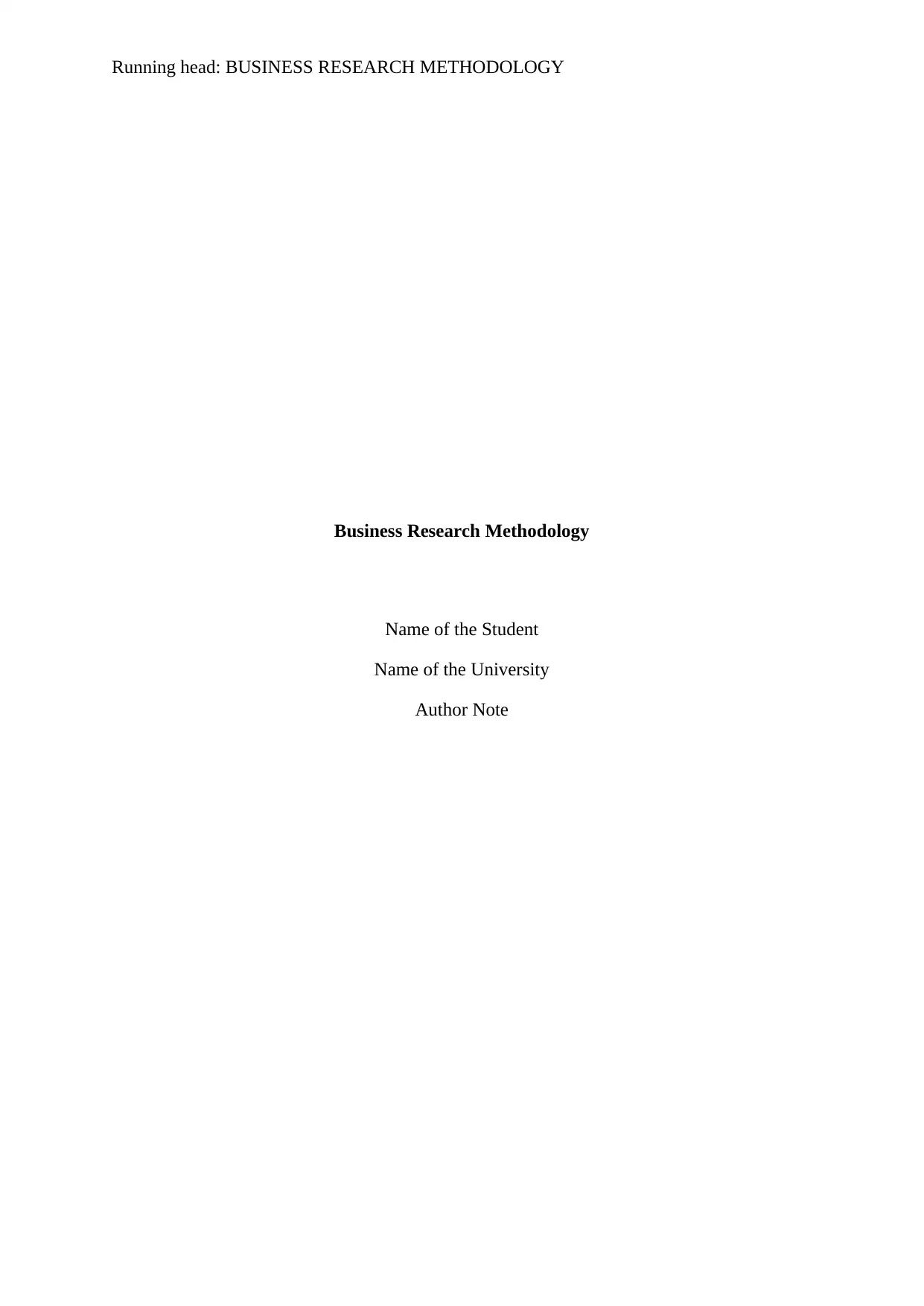
Running head: BUSINESS RESEARCH METHODOLOGY
Business Research Methodology
Name of the Student
Name of the University
Author Note
Business Research Methodology
Name of the Student
Name of the University
Author Note
Paraphrase This Document
Need a fresh take? Get an instant paraphrase of this document with our AI Paraphraser
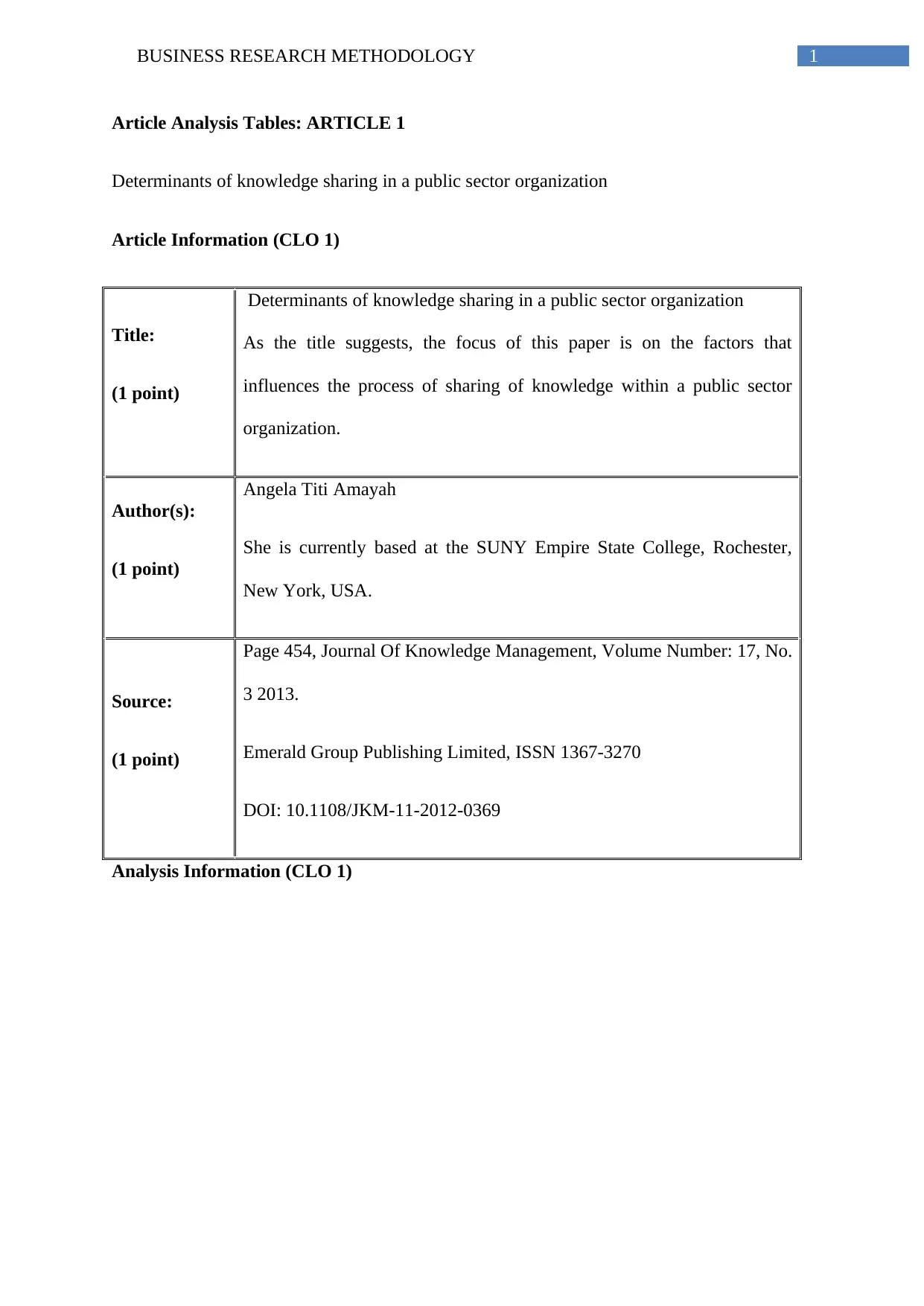
1BUSINESS RESEARCH METHODOLOGY
Article Analysis Tables: ARTICLE 1
Determinants of knowledge sharing in a public sector organization
Article Information (CLO 1)
Title:
(1 point)
Determinants of knowledge sharing in a public sector organization
As the title suggests, the focus of this paper is on the factors that
influences the process of sharing of knowledge within a public sector
organization.
Author(s):
(1 point)
Angela Titi Amayah
She is currently based at the SUNY Empire State College, Rochester,
New York, USA.
Source:
(1 point)
Page 454, Journal Of Knowledge Management, Volume Number: 17, No.
3 2013.
Emerald Group Publishing Limited, ISSN 1367-3270
DOI: 10.1108/JKM-11-2012-0369
Analysis Information (CLO 1)
Article Analysis Tables: ARTICLE 1
Determinants of knowledge sharing in a public sector organization
Article Information (CLO 1)
Title:
(1 point)
Determinants of knowledge sharing in a public sector organization
As the title suggests, the focus of this paper is on the factors that
influences the process of sharing of knowledge within a public sector
organization.
Author(s):
(1 point)
Angela Titi Amayah
She is currently based at the SUNY Empire State College, Rochester,
New York, USA.
Source:
(1 point)
Page 454, Journal Of Knowledge Management, Volume Number: 17, No.
3 2013.
Emerald Group Publishing Limited, ISSN 1367-3270
DOI: 10.1108/JKM-11-2012-0369
Analysis Information (CLO 1)
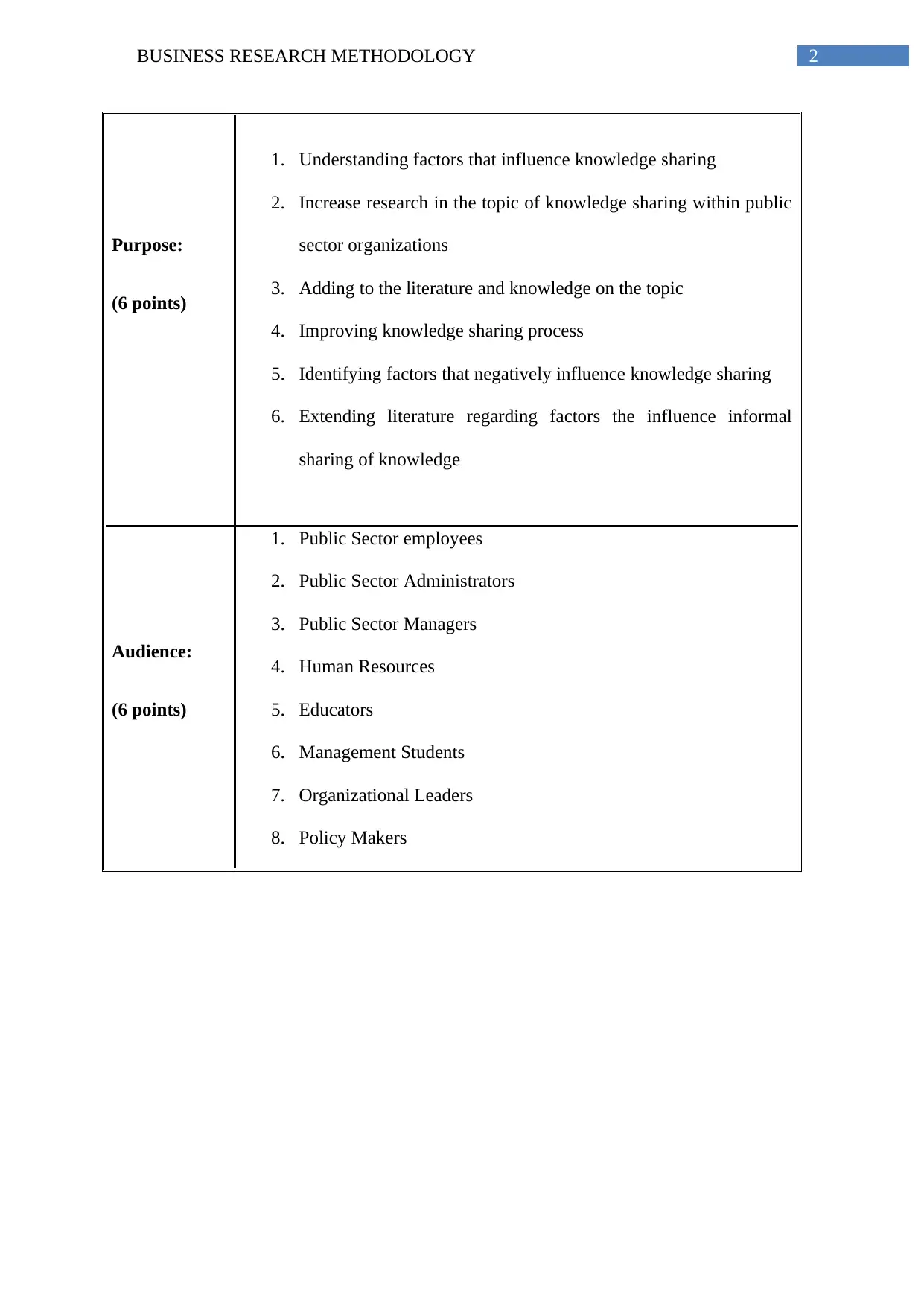
2BUSINESS RESEARCH METHODOLOGY
Purpose:
(6 points)
1. Understanding factors that influence knowledge sharing
2. Increase research in the topic of knowledge sharing within public
sector organizations
3. Adding to the literature and knowledge on the topic
4. Improving knowledge sharing process
5. Identifying factors that negatively influence knowledge sharing
6. Extending literature regarding factors the influence informal
sharing of knowledge
Audience:
(6 points)
1. Public Sector employees
2. Public Sector Administrators
3. Public Sector Managers
4. Human Resources
5. Educators
6. Management Students
7. Organizational Leaders
8. Policy Makers
Purpose:
(6 points)
1. Understanding factors that influence knowledge sharing
2. Increase research in the topic of knowledge sharing within public
sector organizations
3. Adding to the literature and knowledge on the topic
4. Improving knowledge sharing process
5. Identifying factors that negatively influence knowledge sharing
6. Extending literature regarding factors the influence informal
sharing of knowledge
Audience:
(6 points)
1. Public Sector employees
2. Public Sector Administrators
3. Public Sector Managers
4. Human Resources
5. Educators
6. Management Students
7. Organizational Leaders
8. Policy Makers
⊘ This is a preview!⊘
Do you want full access?
Subscribe today to unlock all pages.

Trusted by 1+ million students worldwide
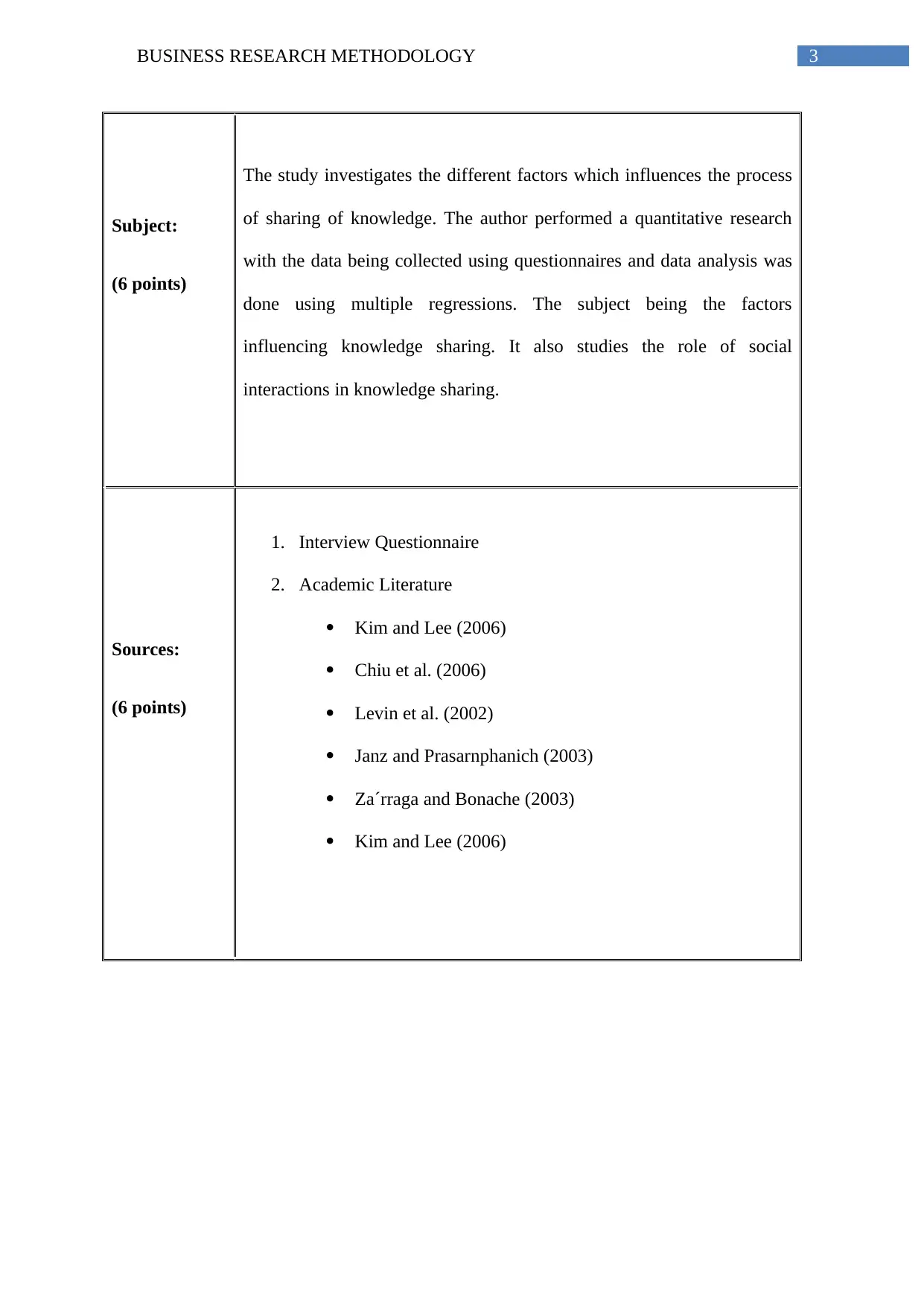
3BUSINESS RESEARCH METHODOLOGY
Subject:
(6 points)
The study investigates the different factors which influences the process
of sharing of knowledge. The author performed a quantitative research
with the data being collected using questionnaires and data analysis was
done using multiple regressions. The subject being the factors
influencing knowledge sharing. It also studies the role of social
interactions in knowledge sharing.
Sources:
(6 points)
1. Interview Questionnaire
2. Academic Literature
Kim and Lee (2006)
Chiu et al. (2006)
Levin et al. (2002)
Janz and Prasarnphanich (2003)
Za´rraga and Bonache (2003)
Kim and Lee (2006)
Subject:
(6 points)
The study investigates the different factors which influences the process
of sharing of knowledge. The author performed a quantitative research
with the data being collected using questionnaires and data analysis was
done using multiple regressions. The subject being the factors
influencing knowledge sharing. It also studies the role of social
interactions in knowledge sharing.
Sources:
(6 points)
1. Interview Questionnaire
2. Academic Literature
Kim and Lee (2006)
Chiu et al. (2006)
Levin et al. (2002)
Janz and Prasarnphanich (2003)
Za´rraga and Bonache (2003)
Kim and Lee (2006)
Paraphrase This Document
Need a fresh take? Get an instant paraphrase of this document with our AI Paraphraser
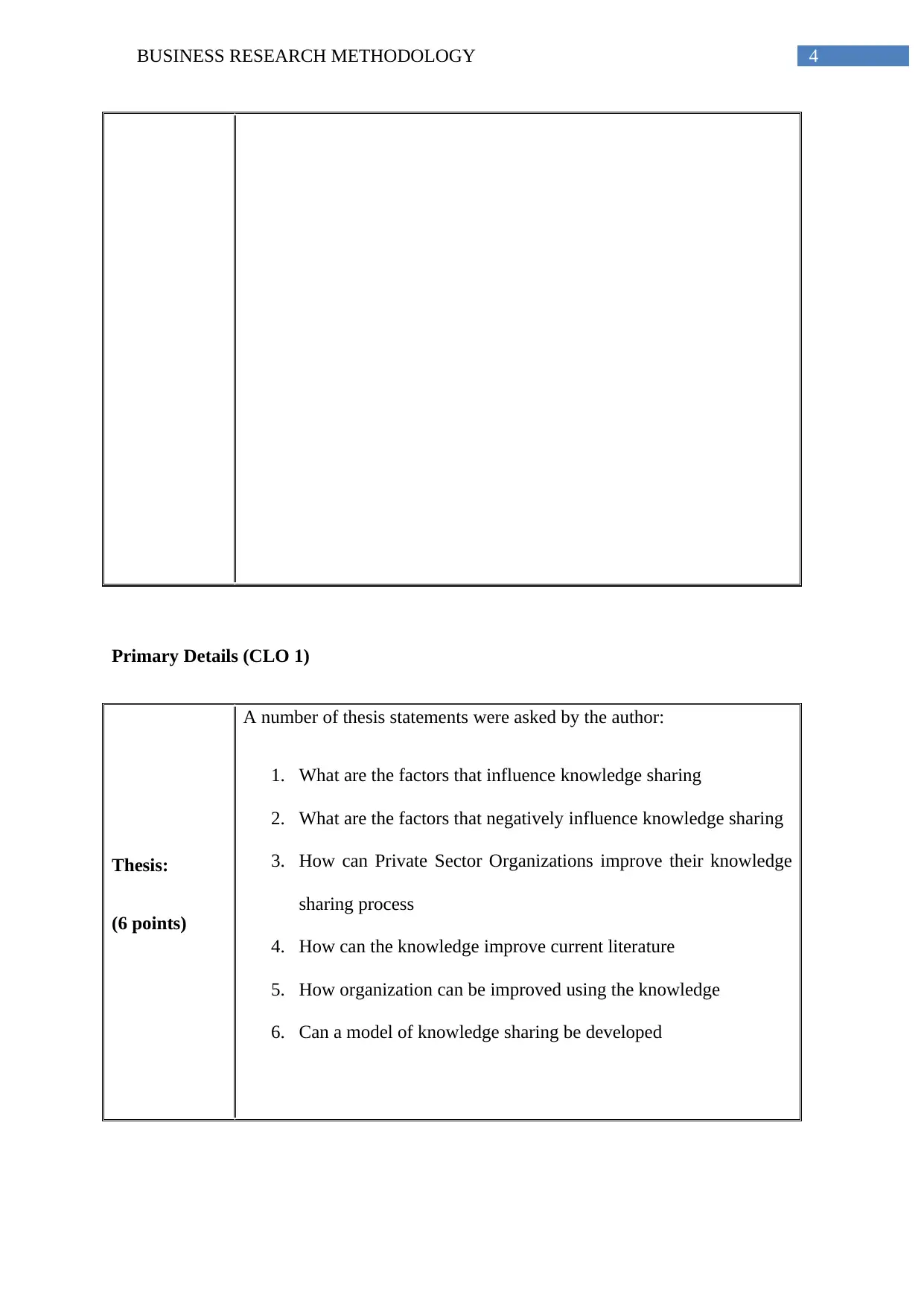
4BUSINESS RESEARCH METHODOLOGY
Primary Details (CLO 1)
Thesis:
(6 points)
A number of thesis statements were asked by the author:
1. What are the factors that influence knowledge sharing
2. What are the factors that negatively influence knowledge sharing
3. How can Private Sector Organizations improve their knowledge
sharing process
4. How can the knowledge improve current literature
5. How organization can be improved using the knowledge
6. Can a model of knowledge sharing be developed
Primary Details (CLO 1)
Thesis:
(6 points)
A number of thesis statements were asked by the author:
1. What are the factors that influence knowledge sharing
2. What are the factors that negatively influence knowledge sharing
3. How can Private Sector Organizations improve their knowledge
sharing process
4. How can the knowledge improve current literature
5. How organization can be improved using the knowledge
6. Can a model of knowledge sharing be developed
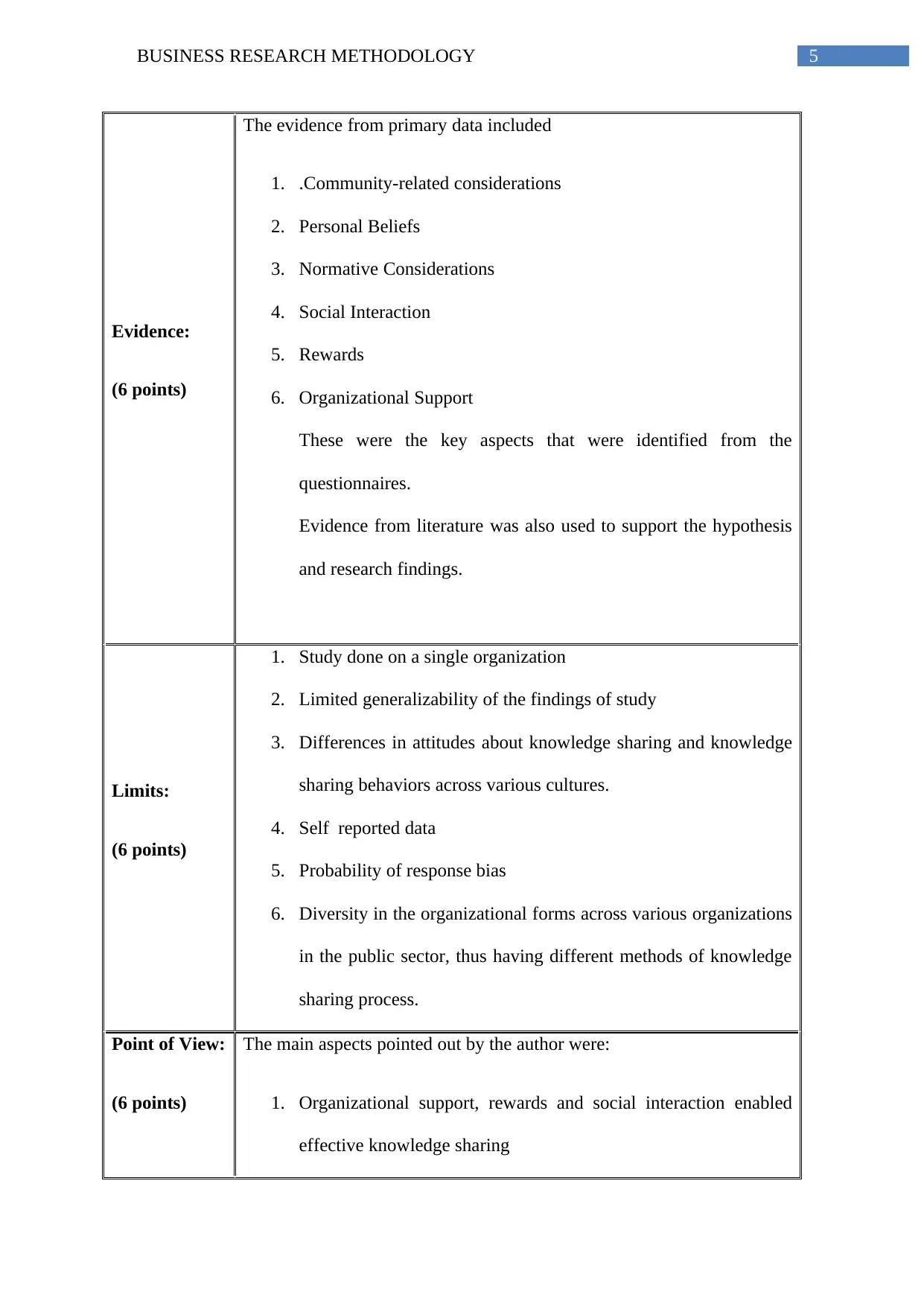
5BUSINESS RESEARCH METHODOLOGY
Evidence:
(6 points)
The evidence from primary data included
1. .Community-related considerations
2. Personal Beliefs
3. Normative Considerations
4. Social Interaction
5. Rewards
6. Organizational Support
These were the key aspects that were identified from the
questionnaires.
Evidence from literature was also used to support the hypothesis
and research findings.
Limits:
(6 points)
1. Study done on a single organization
2. Limited generalizability of the findings of study
3. Differences in attitudes about knowledge sharing and knowledge
sharing behaviors across various cultures.
4. Self reported data
5. Probability of response bias
6. Diversity in the organizational forms across various organizations
in the public sector, thus having different methods of knowledge
sharing process.
Point of View:
(6 points)
The main aspects pointed out by the author were:
1. Organizational support, rewards and social interaction enabled
effective knowledge sharing
Evidence:
(6 points)
The evidence from primary data included
1. .Community-related considerations
2. Personal Beliefs
3. Normative Considerations
4. Social Interaction
5. Rewards
6. Organizational Support
These were the key aspects that were identified from the
questionnaires.
Evidence from literature was also used to support the hypothesis
and research findings.
Limits:
(6 points)
1. Study done on a single organization
2. Limited generalizability of the findings of study
3. Differences in attitudes about knowledge sharing and knowledge
sharing behaviors across various cultures.
4. Self reported data
5. Probability of response bias
6. Diversity in the organizational forms across various organizations
in the public sector, thus having different methods of knowledge
sharing process.
Point of View:
(6 points)
The main aspects pointed out by the author were:
1. Organizational support, rewards and social interaction enabled
effective knowledge sharing
⊘ This is a preview!⊘
Do you want full access?
Subscribe today to unlock all pages.

Trusted by 1+ million students worldwide
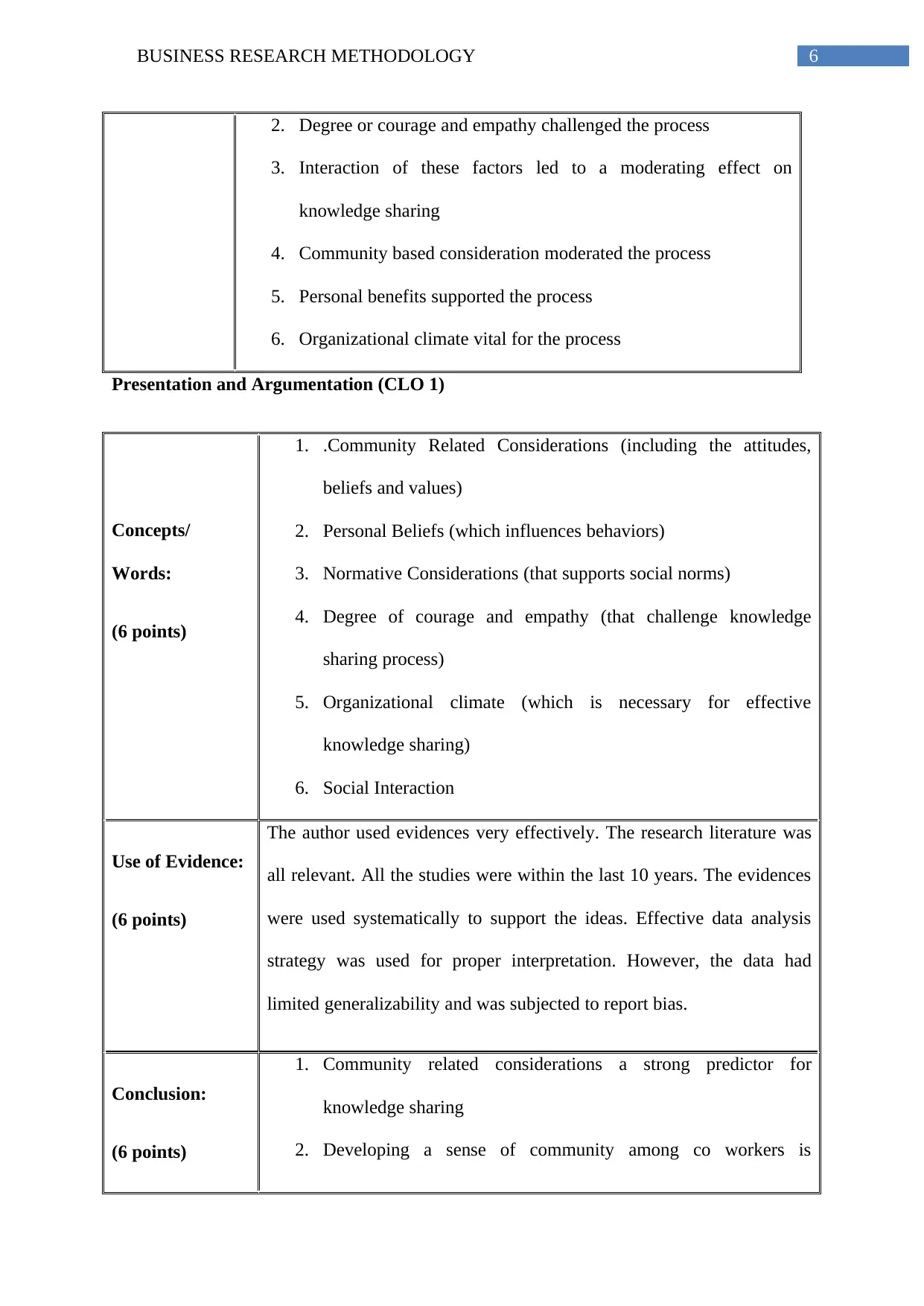
6BUSINESS RESEARCH METHODOLOGY
2. Degree or courage and empathy challenged the process
3. Interaction of these factors led to a moderating effect on
knowledge sharing
4. Community based consideration moderated the process
5. Personal benefits supported the process
6. Organizational climate vital for the process
Presentation and Argumentation (CLO 1)
Concepts/
Words:
(6 points)
1. .Community Related Considerations (including the attitudes,
beliefs and values)
2. Personal Beliefs (which influences behaviors)
3. Normative Considerations (that supports social norms)
4. Degree of courage and empathy (that challenge knowledge
sharing process)
5. Organizational climate (which is necessary for effective
knowledge sharing)
6. Social Interaction
Use of Evidence:
(6 points)
The author used evidences very effectively. The research literature was
all relevant. All the studies were within the last 10 years. The evidences
were used systematically to support the ideas. Effective data analysis
strategy was used for proper interpretation. However, the data had
limited generalizability and was subjected to report bias.
Conclusion:
(6 points)
1. Community related considerations a strong predictor for
knowledge sharing
2. Developing a sense of community among co workers is
2. Degree or courage and empathy challenged the process
3. Interaction of these factors led to a moderating effect on
knowledge sharing
4. Community based consideration moderated the process
5. Personal benefits supported the process
6. Organizational climate vital for the process
Presentation and Argumentation (CLO 1)
Concepts/
Words:
(6 points)
1. .Community Related Considerations (including the attitudes,
beliefs and values)
2. Personal Beliefs (which influences behaviors)
3. Normative Considerations (that supports social norms)
4. Degree of courage and empathy (that challenge knowledge
sharing process)
5. Organizational climate (which is necessary for effective
knowledge sharing)
6. Social Interaction
Use of Evidence:
(6 points)
The author used evidences very effectively. The research literature was
all relevant. All the studies were within the last 10 years. The evidences
were used systematically to support the ideas. Effective data analysis
strategy was used for proper interpretation. However, the data had
limited generalizability and was subjected to report bias.
Conclusion:
(6 points)
1. Community related considerations a strong predictor for
knowledge sharing
2. Developing a sense of community among co workers is
Paraphrase This Document
Need a fresh take? Get an instant paraphrase of this document with our AI Paraphraser
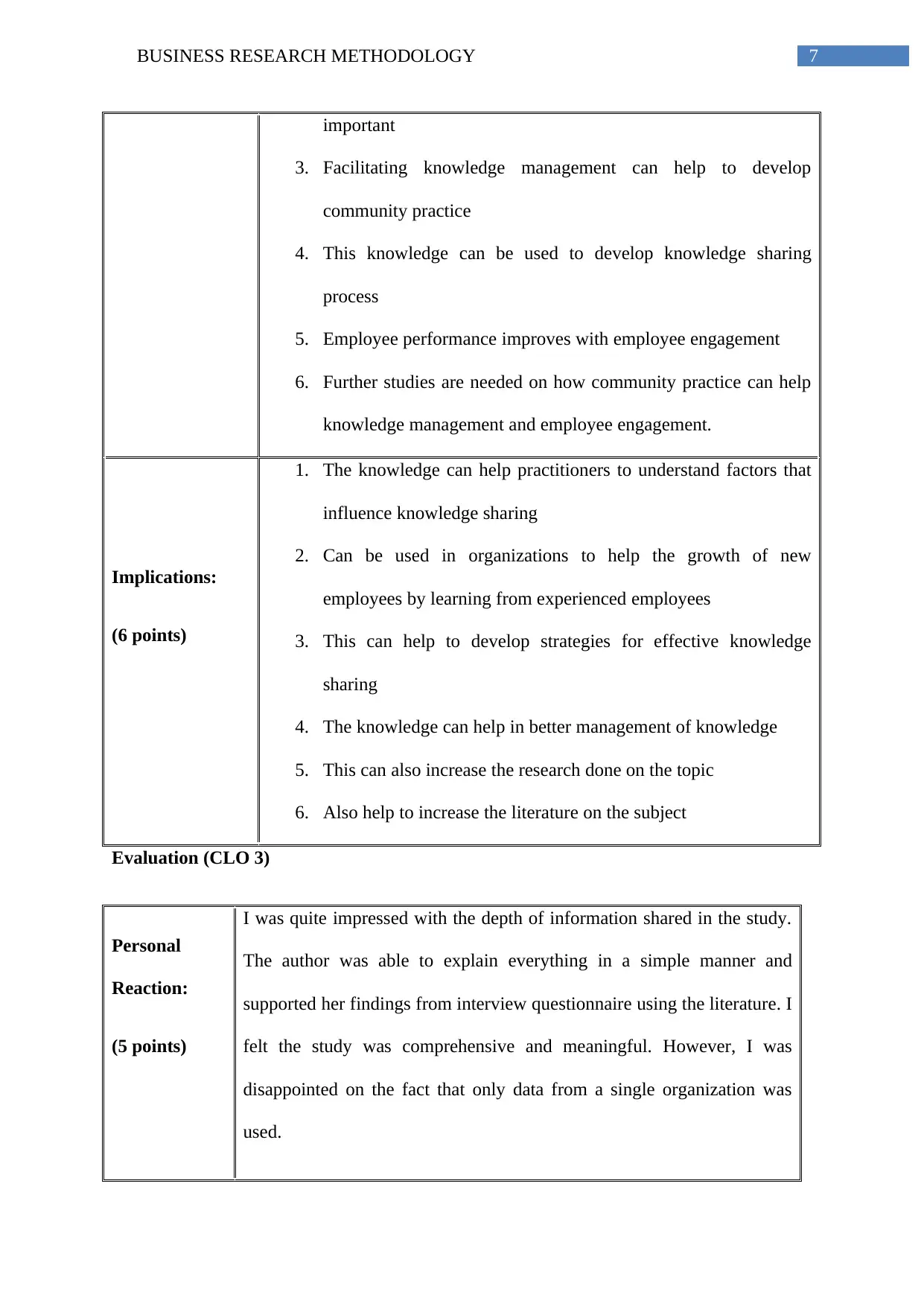
7BUSINESS RESEARCH METHODOLOGY
important
3. Facilitating knowledge management can help to develop
community practice
4. This knowledge can be used to develop knowledge sharing
process
5. Employee performance improves with employee engagement
6. Further studies are needed on how community practice can help
knowledge management and employee engagement.
Implications:
(6 points)
1. The knowledge can help practitioners to understand factors that
influence knowledge sharing
2. Can be used in organizations to help the growth of new
employees by learning from experienced employees
3. This can help to develop strategies for effective knowledge
sharing
4. The knowledge can help in better management of knowledge
5. This can also increase the research done on the topic
6. Also help to increase the literature on the subject
Evaluation (CLO 3)
Personal
Reaction:
(5 points)
I was quite impressed with the depth of information shared in the study.
The author was able to explain everything in a simple manner and
supported her findings from interview questionnaire using the literature. I
felt the study was comprehensive and meaningful. However, I was
disappointed on the fact that only data from a single organization was
used.
important
3. Facilitating knowledge management can help to develop
community practice
4. This knowledge can be used to develop knowledge sharing
process
5. Employee performance improves with employee engagement
6. Further studies are needed on how community practice can help
knowledge management and employee engagement.
Implications:
(6 points)
1. The knowledge can help practitioners to understand factors that
influence knowledge sharing
2. Can be used in organizations to help the growth of new
employees by learning from experienced employees
3. This can help to develop strategies for effective knowledge
sharing
4. The knowledge can help in better management of knowledge
5. This can also increase the research done on the topic
6. Also help to increase the literature on the subject
Evaluation (CLO 3)
Personal
Reaction:
(5 points)
I was quite impressed with the depth of information shared in the study.
The author was able to explain everything in a simple manner and
supported her findings from interview questionnaire using the literature. I
felt the study was comprehensive and meaningful. However, I was
disappointed on the fact that only data from a single organization was
used.
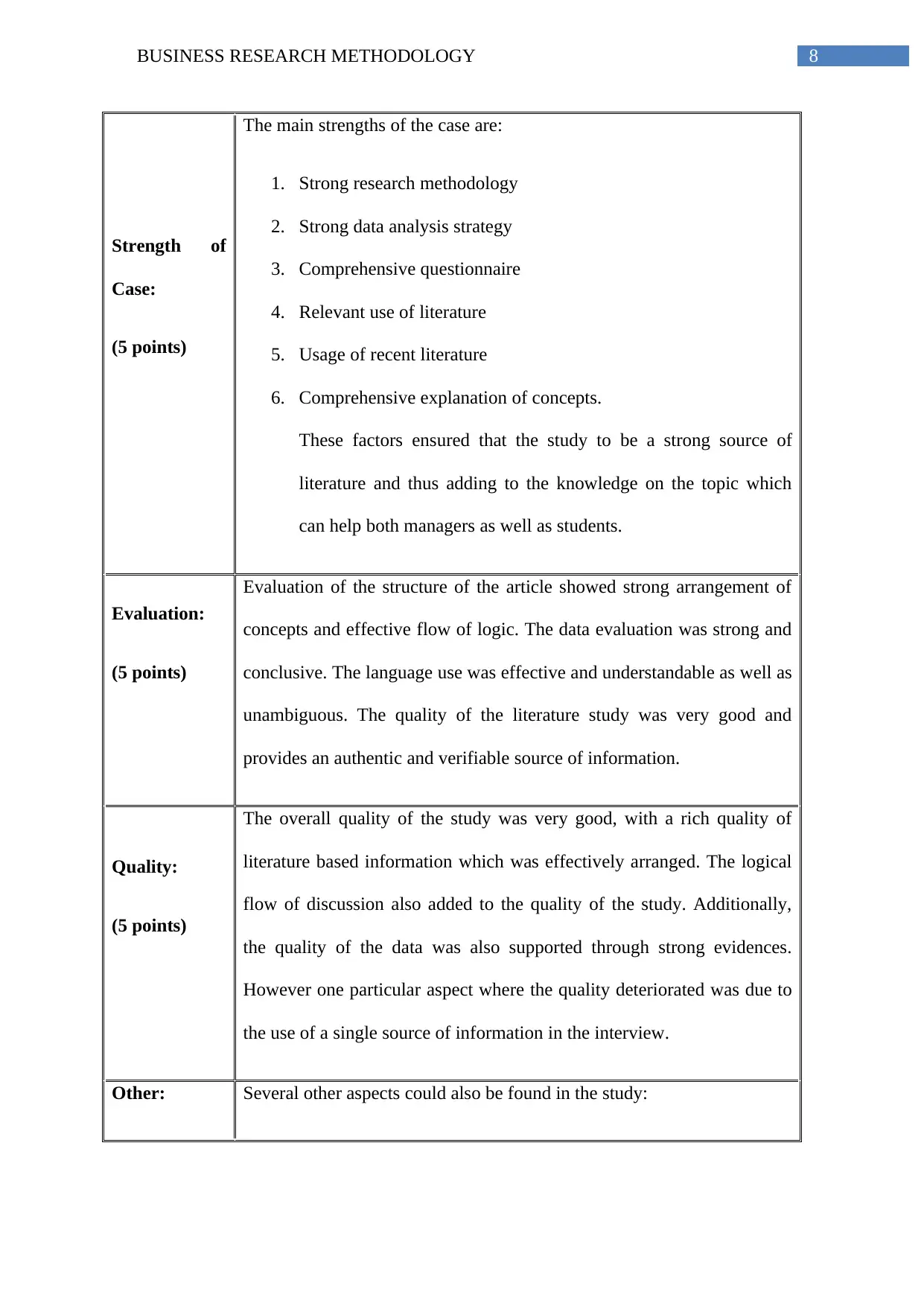
8BUSINESS RESEARCH METHODOLOGY
Strength of
Case:
(5 points)
The main strengths of the case are:
1. Strong research methodology
2. Strong data analysis strategy
3. Comprehensive questionnaire
4. Relevant use of literature
5. Usage of recent literature
6. Comprehensive explanation of concepts.
These factors ensured that the study to be a strong source of
literature and thus adding to the knowledge on the topic which
can help both managers as well as students.
Evaluation:
(5 points)
Evaluation of the structure of the article showed strong arrangement of
concepts and effective flow of logic. The data evaluation was strong and
conclusive. The language use was effective and understandable as well as
unambiguous. The quality of the literature study was very good and
provides an authentic and verifiable source of information.
Quality:
(5 points)
The overall quality of the study was very good, with a rich quality of
literature based information which was effectively arranged. The logical
flow of discussion also added to the quality of the study. Additionally,
the quality of the data was also supported through strong evidences.
However one particular aspect where the quality deteriorated was due to
the use of a single source of information in the interview.
Other: Several other aspects could also be found in the study:
Strength of
Case:
(5 points)
The main strengths of the case are:
1. Strong research methodology
2. Strong data analysis strategy
3. Comprehensive questionnaire
4. Relevant use of literature
5. Usage of recent literature
6. Comprehensive explanation of concepts.
These factors ensured that the study to be a strong source of
literature and thus adding to the knowledge on the topic which
can help both managers as well as students.
Evaluation:
(5 points)
Evaluation of the structure of the article showed strong arrangement of
concepts and effective flow of logic. The data evaluation was strong and
conclusive. The language use was effective and understandable as well as
unambiguous. The quality of the literature study was very good and
provides an authentic and verifiable source of information.
Quality:
(5 points)
The overall quality of the study was very good, with a rich quality of
literature based information which was effectively arranged. The logical
flow of discussion also added to the quality of the study. Additionally,
the quality of the data was also supported through strong evidences.
However one particular aspect where the quality deteriorated was due to
the use of a single source of information in the interview.
Other: Several other aspects could also be found in the study:
⊘ This is a preview!⊘
Do you want full access?
Subscribe today to unlock all pages.

Trusted by 1+ million students worldwide
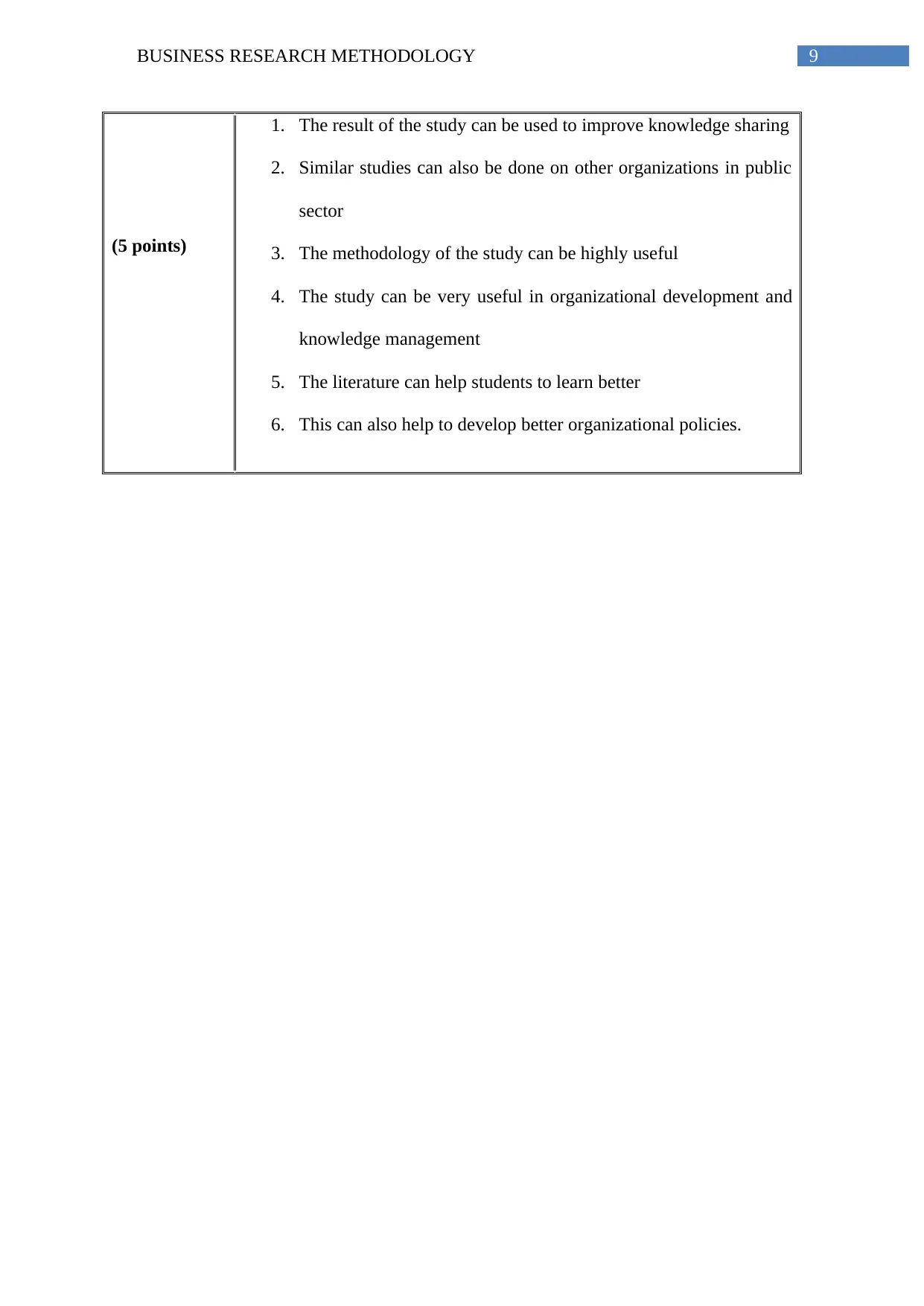
9BUSINESS RESEARCH METHODOLOGY
(5 points)
1. The result of the study can be used to improve knowledge sharing
2. Similar studies can also be done on other organizations in public
sector
3. The methodology of the study can be highly useful
4. The study can be very useful in organizational development and
knowledge management
5. The literature can help students to learn better
6. This can also help to develop better organizational policies.
(5 points)
1. The result of the study can be used to improve knowledge sharing
2. Similar studies can also be done on other organizations in public
sector
3. The methodology of the study can be highly useful
4. The study can be very useful in organizational development and
knowledge management
5. The literature can help students to learn better
6. This can also help to develop better organizational policies.
Paraphrase This Document
Need a fresh take? Get an instant paraphrase of this document with our AI Paraphraser
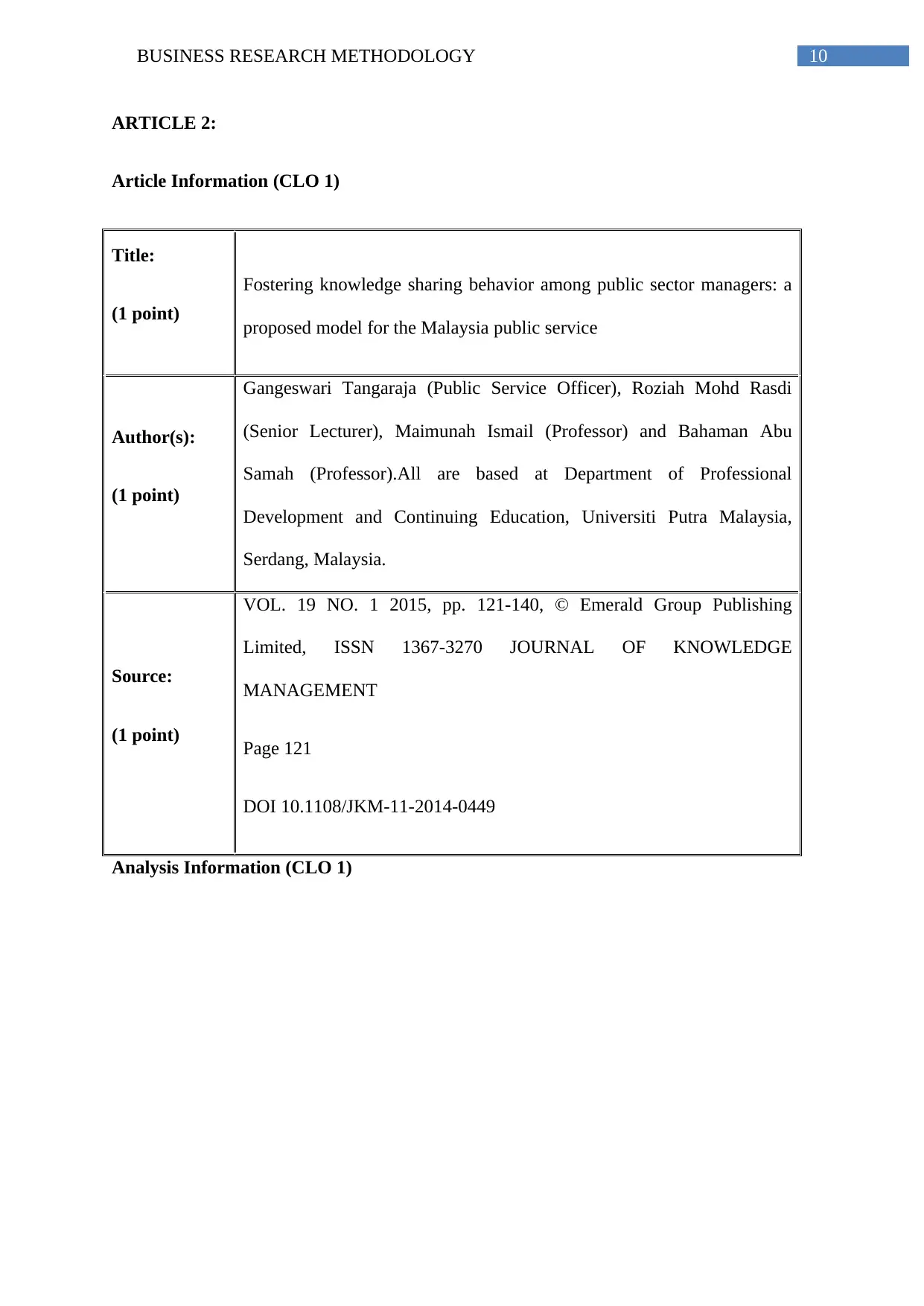
10BUSINESS RESEARCH METHODOLOGY
ARTICLE 2:
Article Information (CLO 1)
Title:
(1 point)
Fostering knowledge sharing behavior among public sector managers: a
proposed model for the Malaysia public service
Author(s):
(1 point)
Gangeswari Tangaraja (Public Service Officer), Roziah Mohd Rasdi
(Senior Lecturer), Maimunah Ismail (Professor) and Bahaman Abu
Samah (Professor).All are based at Department of Professional
Development and Continuing Education, Universiti Putra Malaysia,
Serdang, Malaysia.
Source:
(1 point)
VOL. 19 NO. 1 2015, pp. 121-140, © Emerald Group Publishing
Limited, ISSN 1367-3270 JOURNAL OF KNOWLEDGE
MANAGEMENT
Page 121
DOI 10.1108/JKM-11-2014-0449
Analysis Information (CLO 1)
ARTICLE 2:
Article Information (CLO 1)
Title:
(1 point)
Fostering knowledge sharing behavior among public sector managers: a
proposed model for the Malaysia public service
Author(s):
(1 point)
Gangeswari Tangaraja (Public Service Officer), Roziah Mohd Rasdi
(Senior Lecturer), Maimunah Ismail (Professor) and Bahaman Abu
Samah (Professor).All are based at Department of Professional
Development and Continuing Education, Universiti Putra Malaysia,
Serdang, Malaysia.
Source:
(1 point)
VOL. 19 NO. 1 2015, pp. 121-140, © Emerald Group Publishing
Limited, ISSN 1367-3270 JOURNAL OF KNOWLEDGE
MANAGEMENT
Page 121
DOI 10.1108/JKM-11-2014-0449
Analysis Information (CLO 1)
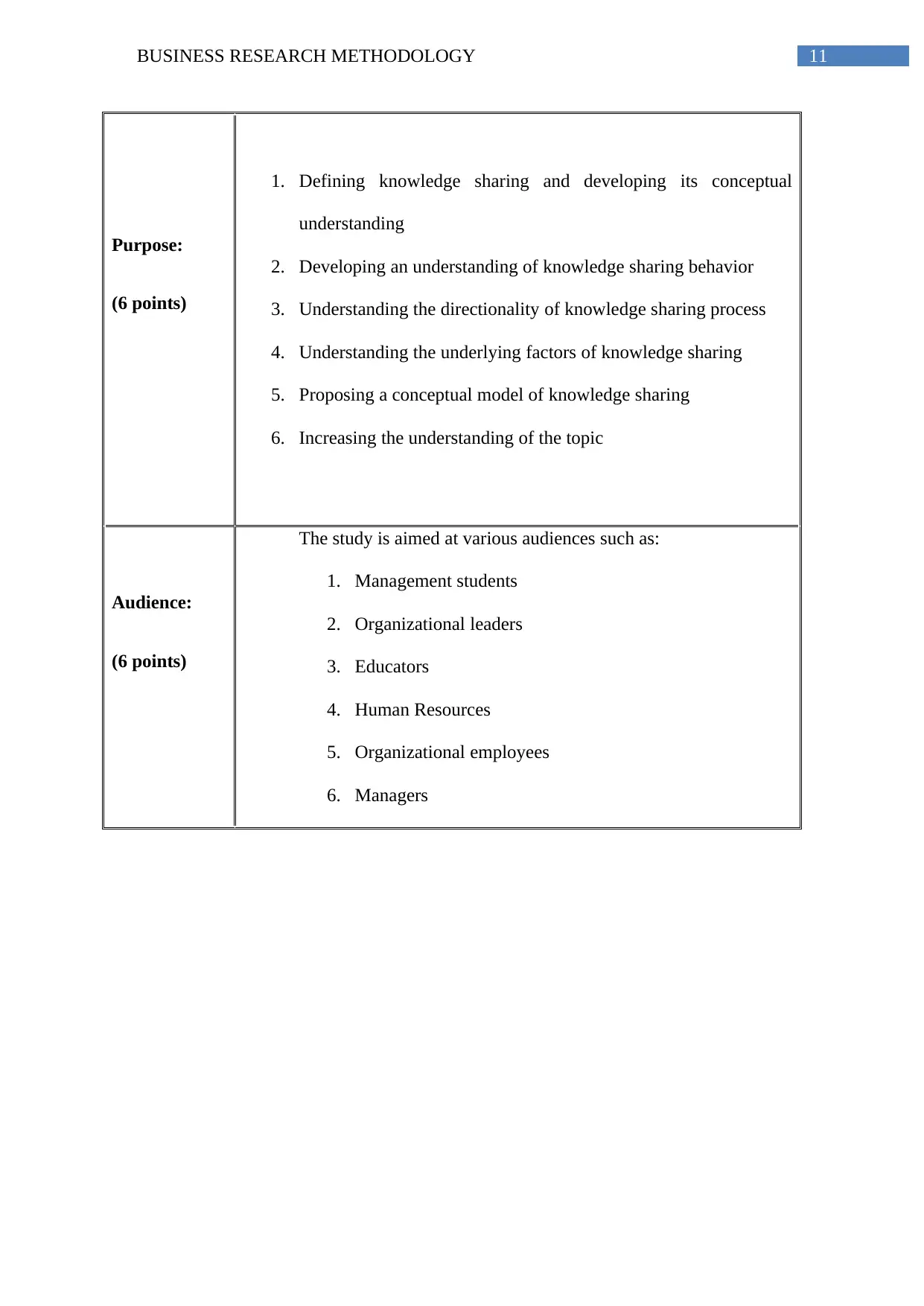
11BUSINESS RESEARCH METHODOLOGY
Purpose:
(6 points)
1. Defining knowledge sharing and developing its conceptual
understanding
2. Developing an understanding of knowledge sharing behavior
3. Understanding the directionality of knowledge sharing process
4. Understanding the underlying factors of knowledge sharing
5. Proposing a conceptual model of knowledge sharing
6. Increasing the understanding of the topic
Audience:
(6 points)
The study is aimed at various audiences such as:
1. Management students
2. Organizational leaders
3. Educators
4. Human Resources
5. Organizational employees
6. Managers
Purpose:
(6 points)
1. Defining knowledge sharing and developing its conceptual
understanding
2. Developing an understanding of knowledge sharing behavior
3. Understanding the directionality of knowledge sharing process
4. Understanding the underlying factors of knowledge sharing
5. Proposing a conceptual model of knowledge sharing
6. Increasing the understanding of the topic
Audience:
(6 points)
The study is aimed at various audiences such as:
1. Management students
2. Organizational leaders
3. Educators
4. Human Resources
5. Organizational employees
6. Managers
⊘ This is a preview!⊘
Do you want full access?
Subscribe today to unlock all pages.

Trusted by 1+ million students worldwide
1 out of 21
Related Documents
Your All-in-One AI-Powered Toolkit for Academic Success.
+13062052269
info@desklib.com
Available 24*7 on WhatsApp / Email
![[object Object]](/_next/static/media/star-bottom.7253800d.svg)
Unlock your academic potential
Copyright © 2020–2025 A2Z Services. All Rights Reserved. Developed and managed by ZUCOL.





